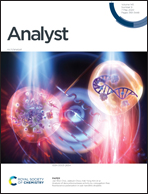Colorimetric identification of lanthanide ions based on two carboxylic acids as an artificial tongue†
Abstract
We report a colorimetric array, which consists of two carboxylic acids (quinolinic acid (QA), tannic acid (TCA)) as the sensor element and Eriochrome Black T (EBT) as the colorimetric signal readout. The assay is based on coordination binding between lanthanide ions and EBT, and between lanthanide ions and the carboxylic acids. The competitive binding of lanthanide ions with the carboxylic acids and EBT leads to the change in absorbance and color of the solutions. To test the efficacy of our sensor array, the sensor array was exposed to five target lanthanide ions (La3+, Sm3+, Eu3+, Gd3+ and Yb3+) with diverse concentrations (10, 50, 100, 200, 300, 400, and 500 nM). Linear discriminant analysis (LDA) results show that the sensor array can identify the five lanthanide ions, with a low discrimination limit of 10 nM. More importantly, the sensor array realizes fast discrimination of lanthanide ions in river samples, showing potential in environmental monitoring.



 Please wait while we load your content...
Please wait while we load your content...